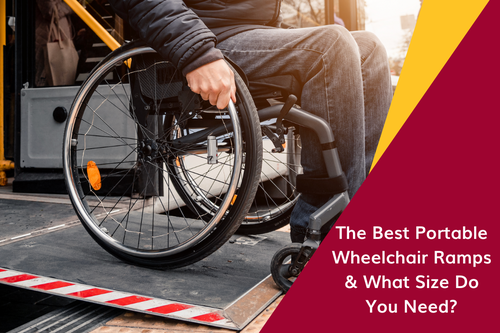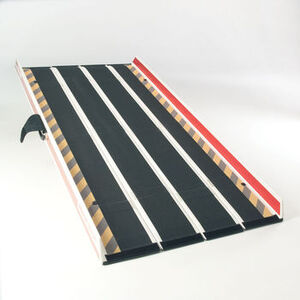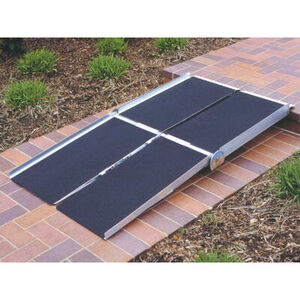At Access Rehabilitation Equipment, we commit to providing you and your loved ones solutions for life! Fitting your lifestyle, each aid and equipment is tailored to the unique challenges you are facing, so work with us to find the independence and mobility you want!

In this article, we'll explore the best options available in the market and guide you in choosing the right size to meet your specific needs.
Why might you need a portable ramp?
A portable ramp, or a temporary wheelchair ramp, is useful if you rely on a wheelchair or mobility scooter to get around. Designed to be lightweight, compact, and easy to carry, folding wheelchair ramps are perfect for ensuring that you always have a wheelchair-accessible entrance wherever you go. Whether facing challenges entering buildings or vehicles, or needing assistance with stairs, a portable ramp provides versatility and convenience in overcoming such barriers.
Where can portable wheelchair ramps be used?
Portable wheelchair ramps serve as essential tools to enhance accessibility in various settings. Here are some common places where portable wheelchair ramps prove useful:
- Homes: Entryways with steps or elevated thresholds at home can be made accessible with portable ramps.
- Curbs and Gutters: Portable wheelchair ramps are designed to overcome curbs and gutters, providing a smooth transition for wheelchair users.
- Access to buildings: These ramps are commonly employed to enhance accessibility to buildings, ensuring that entrances are barrier-free for individuals with mobility challenges.
- Access to vehicles: Portable wheelchair ramps facilitate easy access to vehicles and public transportation like buses and trains, allowing wheelchair users to board and disembark with convenience and independence.
- Outdoor venues: Temporary wheelchair ramps can be used at outdoor venues, such as parks or stadiums, to provide easy navigation of elevated platforms and uneven surfaces.
How do I choose a portable ramp?
Choosing a portable ramp involves considering several factors to ensure it meets your specific needs. Here are some key considerations:
- Ramp type: Select a ramp type based on your requirements, such as a suitcase ramp for travel, a threshold ramp for doorways, or a multifold ramp for various settings.
- Weight capacity: Ensure the ramp's weight capacity accommodates both your wheelchair or mobility scooter and your weight. Choose a ramp with a capacity higher than your total weight for safety.
- Length: The ramp's length should be proportionate to the entrance height to ensure a safe and gradual incline. For homes with minimal steps, a shorter, portable ramp may be the simplest solution. However, if the entrance is higher, a larger ramp system is likely necessary. Some vehicles used to transport assistive mobility devices are also taller and might require a longer ramp.
- Portability: If you plan to transport the ramp frequently, choose one that is foldable, lightweight, and easy to carry.
- Installation: Quick and hassle-free setup can make a world of difference, especially when you're on the go. Choose a ramp that is easy to install and set up. Some ramps have additional features like handles or carry bags for convenience.
- Surface Material: Look for ramps with a slip-resistant surface for safety. Different surface materials, such as aluminum or rubber, offer varying degrees of traction.
Types of mobility ramps
There are several types of wheelchair ramps designed to meet various accessibility needs. Here are some common types:
Telescoping ramps: Ideal for small elevation changes like door thresholds. Telescoping ramps provide a smooth transition from one surface to another. They are called telescopic ramps because each section and ramp can be deployed, extending the total length and forming a slope with the least possible inclination.
Edge barrier portable ramps: With the added security of edge barriers, these types of portable ramps are suited for access to buildings, vehicles, buses, trains, or situations where a permanent ramp is impractical. The Decpac Edge Barrier Limited Portable Ramp folds easily for storage and transportation and can be deployed in seconds.

Folding portable ramps: If you need a temporary or portable solution, folding wheelchair ramps are an excellent choice. They come in bi-fold (two panels) and quad-fold (four panels) options. Our Multi-folding wheelchair ramps, featuring a unique foldable design, offer convenience in both carrying and storage. Constructed from lightweight aluminum, they are easy to transport and can support loads of up to 360kg.

What are the requirements for a portable wheelchair ramp?
Navigating thresholds, curbs, or uneven surfaces becomes seamless with portable wheelchair ramps, acting as essential connectors between spaces and allowing users of wheelchairs or mobility devices easy access. However, to guarantee safety and accessibility, it's crucial that these ramps adhere to specific requirements and guidelines—whether you are installing one in a commercial location or at your home.
- Slope: The general principle for ramp slopes is that longer ramps need a more gradual slope to ensure that wheelchair users can maintain enough speed to reach the top. The slope of a ramp measuring 190 centimeters should not exceed 1:10 of its length. Smaller ramps should maintain a slope below 1:8, while ramps longer than 190 centimeters should have a minimum slope of 1:14. Threshold ramps in doorways may have a slope of up to 1:8 if they are 3.5 cm high or less.
- Width: The AS 1428.1 requires a 100cm minimum clear width between handrails for a straight ramp. In cases of directional changes, the width at the turning point should expand based on the turn angle to accommodate a wheelchair’s turning arc. For a fully curved ramp, a minimum clear width of 150cm is required.
- Landings: Landings should be provided at the top and bottom of the ramp to offer a level of space for users to rest or maneuver safely.
- Non-skid features: In compliance with the DDA and AS regulations, long and steep ramps, especially those exceeding 190 centimetres in length, must have non-skid features. These features may include textured surfaces, grip tape, traction mats, and other anti-slip measures to enhance safety.
- Handrails: According to the guidelines outlined in AS 1428.1-2009, it is essential to design and install handrails in strict accordance with specified standards to guarantee their safe and effective use by individuals with disabilities.Handrails are recommended to feature an elliptical or circular cross-section with a diameter ranging from 3 to 5 centimetres. The top portion of the handrail should also be positioned approximately 86.5 to 100 centimetres above the ramp's surface.
What size portable wheelchair ramp do I need?
To determine the size of the portable wheelchair ramp you need, follow these steps:
- Measure the Height: Determine the height difference between the lower and upper surfaces you need to navigate. For example, measure from the ground to the top of the step or threshold.
- Calculate Length Based on Slope: Use the recommended slope ratio of 1:14. This means that for every 1 meter of rise (vertical height), the ramp should extend at least 14 meters horizontally, so if you have a rise of 15 centimeters, your ramp should be at least 2.1 meters long (15 x 14).
- Consider the Width: Ensure the ramp is wide enough to accommodate the wheelchair comfortably. A minimum width of 100 centimetres is recommended, but wider ramps may be necessary for larger wheelchairs or for users who prefer more space.
- Evaluate Available Space: Check that you have enough space for the ramp. Consider factors such as the layout of the area, any obstructions, and the space needed for turning at the top and bottom of the ramp.
How do I know if a folding wheelchair ramp will work for me?
Determining if a folding wheelchair ramp will suit your needs is essential for a confident purchase. Here are few practical tips to help you decide:
- Showroom Test: Visit one of our showrooms to try out a similar ramp. This hands-on experience allows you to assess its usability and suitability for your specific requirements.
- Rent Before Purchasing: Consider renting a ramp for a week or however long it takes for you to evaluate its benefits. This trial period allows you to test the ramp in your everyday life and determine if it addresses your mobility needs effectively.
- Consider Storage Space: Take into account the storage space available in your home or vehicle for the folded ramp. Ensure it can be conveniently stored when not in use.
- Consult with Professionals: If you have specific mobility concerns, consult with healthcare professionals or specialists for personalized recommendations.
Conclusion
By understanding your specific needs and utilizing the guidelines provided, you can make an informed decision that enhances your mobility and overall quality of life. Remember, the right size matters, and with the right portable ramp, you're not just overcoming physical barriers – you're embracing a path towards a more inclusive and empowered lifestyle.


 Providing solutions for life
Providing solutions for life







